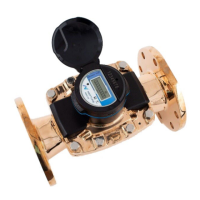Commercial and lndustrial MACH 10
®
Ultrasonic Meter Installation and Maintenance Guide 25
Chapter 6: Testing the Commercial and Industrial MACH 10
®
Bench Testing the Commercial and Industrial MACH 10
®
Meter
Unlike other solid state meters introduced to the market, the Neptune MACH 10 Ultrasonic
Meter is designed to be bench tested as a traditional mechanical meter. However, there are
certain best practices you should adhere to when testing the C&I MACH 10 meter.
A summary of these are in the following sections.
Meter Accuracy Testing Guidelines
Following are guidelines for testing meter accuracy:
l Conduct meter accuracy tests at a stable flow rate, and keep the variation in flow rates to a
minimum during the test.
l Minimize the time it takes to start and stop the test flow rate. Starting the flow should be
quicker than stopping the flow to prevent water hammer during the valve closing.
l MACH 10 meters have remarkable low-flow sensitivity. Conducting meter accuracy tests at
low-flow rates on a test bench designed to test large meters is challenging, so take care to
ensure reliable and consistent results.
l Regularly inspect the test bench to ensure there are no leaks or leaking valves downstream
of the meter. Any slight diversion of water away for the tank makes it appear that the
meters are over-registering.
l If you test over a range of flow rates, start at the highest flow rate and end with the lowest.
This helps ensure that all air is purged before reaching the more critical low flow tests.
l AWWA C-715 specifies visual reading capacity requirements, which dictates the value of
the most significant digit. The MACH 10 has a nine-digit LCD display that together with the
AWWA capacity requirement determines the resolution of the least-significant digit.
Consequently, to ensure that reading errors are acceptably low, run sufficient volumes of
water during low-flow testing. Refer to "Test Data " on page28 for Neptune's
recommended test volumes.
l To achieve necessary tank volume precision, low-flow testing should use the smallest
practicable tank.
l Best practice is to test three times at each flow rate and average the three results to report
the meter accuracy at that flow.

